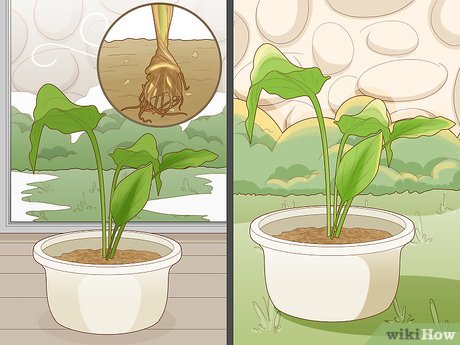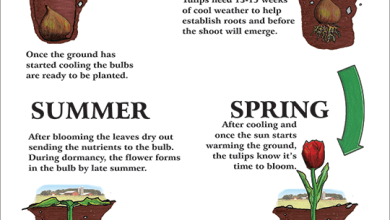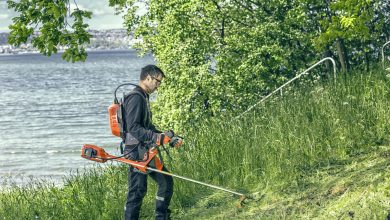How to Plant Turmeric: Complete Guide + [Step by Step]

Did you know that lately numerous studies are being carried out in reference to the beneficial properties of turmeric?
Turmeric is a plant native to India, but it can live in other places with hot climates.
It is used as a condiment in Hindu cuisine as well as for religious celebrations. However, numerous benefits are attributed to it when consumed regularly and therefore it is considered a medicinal plant.
The turmeric plant can reach1 meter high.
Important Points when Sowing Turmeric:
- When? Any time of the year is good, but you must take into account the temperature and humidity conditions.

- Where? Place of good sun exposure, with temperatures between 18º and 35º centigrade. High humidity percentage.
- How long does it take to grow? Between 6 and 10 months after sowing.
- How do we water? We needmoist soil, but without flooding. Ideal drip irrigation, every two days.
- How do we prepare the land? Turmeric develops in land with a relatively low PH, since it is between 4.5 and 7.
- How to sow? Here step by step.
- How do we harvest? With a knife, dig up a small part of the root, being careful not to pull it with your hands, and cut the piece that you are going to use.
- Favorable associations? Peppermint, garlic and calendula.
- Plagues and diseases? Mainly the aphid.
Turmeric Characteristics
- Botanical name: Curcuma longa.
- Common Name: Turmeric, common turmeric, turmeric root.
- Plant type: Herbaceous perennial.
- Size at maturity: 90 to 120 cm tall and wide.
- Sun Exposure: Full sun in far north, partial sun elsewhere.
- Soil type: Rich, well drained and constantly moist.
- Soil pH: Slightly acidic to slightly alkaline.
- Flowering time: July to August.
- Color of flowers (bracts): Burgundy, green, pink, white, yellow or bicolor.
- Hardiness Zones: USDA 8 to 11.
- Area of origin: India and Malaysia.
Turmeric is a tropical plant.
Its rhizomes have traditionally been used in food preparation and as medicine. It belongs to the ginger family (Zingiberaceae) and, like ginger, is considered a spice. Another feature it shares with ginger is a showy flower (although the showy part is actually a bract, not the true flower), signifying additional use for the plant as an ornamental. The canna -like leaves make it an attractive foliage plant even when there are no flowers.
crop association
You can plant it together with mint, garlic or calendula to drive away pests.
Where to plant turmeric?
 Turmeric can be planted both in a pot and in a garden along with other plants.
Turmeric can be planted both in a pot and in a garden along with other plants.
You have to pay attention that between the turmeric and the plant next to it is at40 centimeters away.
In the event that you use a pot that is 40 centimeters in diameter and with a depth of at least 30 centimeters.
If the root has grown too much, transplant it into a pot about 50 centimeters deep.
When do we start the turmeric plantation?
You can plant it inany time of the year.
Important considerations are temperature and humidity.
This presents aoptimal development between 18° and 35° degreescentigrade; but it is advisable to take an average value and not the extremes of temperature in which it can develop.
On the other hand, this plant develops in areas with a high percentage of humidity. If you do not live in the area described, you can choose to grow it in a greenhouse.
How do we prepare the land?
 Turmeric is normally given inloamy land to allow aerationof the underground part.
Turmeric is normally given inloamy land to allow aerationof the underground part.
You have to find amoist medium at the rootso that it can grow, therefore, add three parts of substrate to one of humus to provide it with nutrients at the same time.
Turmeric develops in soils with a relatively low pH, since it is between 4.5 and 7. It is recommended that you keep the value around 6.
How do we water turmeric?
Once the turmeric is planted, you canwater every two days keeping the soil moistwithout letting it puddle.
Being a plant with high water requirements, you need to use a substrate or a grid so that the water drains without problems.
Grow Turmeric step by step
- First make sure you have a pot of the requested measures and have prepared the soil with substrate, humus or compost and that it is loam (it does not matter if it is sandy loam or clay loam).
- You can use coconut fiber, peat, vermiculite, perlite and tezontle or tepojal as a substrate.
- You decide if you use only one of them or combine them. By adding it you will help ensure good aeration, good drainage and the weight of the planter is not excessive, as these substrates have very little weight.
- Turmeric is not a seed but a root, so you have to make a hole in the ground approximately the depth of the rhizome (it is the part from which the shoots will grow).
- Bury it carefully and cover it with soil without crushing it, exposing the buds of the roots that have not yet germinated. She waters immediately and waits for the shoots to germinate.
- Turmeric requires both plenty of water and nutrients, especially in the early stages. So if you notice that the sprouts are still very small, it is probably because they lack water.
- Add homemade organic matter such as compost every ten months or so.
When and how is it harvested?
 Amongsix and ten months after plantingthe rhizomes will already have grown enough to be harvested.
Amongsix and ten months after plantingthe rhizomes will already have grown enough to be harvested.
With a knife, dig up a small part of the root, being careful not to pull it with your hands, and cut the piece that you are going to use. Then cover carefully and let it grow again.
If the plant is constantly watered, it will continue to grow for very long periods.
If you want to store the root once you have already cut it, you have to let it dry for one or two months until it is completely dry.
If it takes too long due to the weather, you can choose to dry it in an oven (without direct exposure to fire). Once dry, you can pulverize it and use it as a condiment for food and drinks.
What pests and diseases does turmeric have?
This root is usually attackedmainly by aphids.Which can be eliminated by extracting tobacco.
Peppermint extract or rhubarb infusion are also effective. If you do not have any of these substances, you can wash with potassium soap or preferably spray Neem oil.
To prevent aphids it is necessary that you eliminate weeds and regularly check the plant. If the pest has already attacked, you need to act quickly because aphids have a very high rate of reproduction.
Turmeric Benefits
 Turmeric is a root considered by many to be one of the best medicinal plants for its positive effects on the human body.
Turmeric is a root considered by many to be one of the best medicinal plants for its positive effects on the human body.
It works like agreat antioxidant thanks to its high content of curcumin.
These antioxidants eliminate free radicals reducing the chances of getting cancer.
It is also known for its anti-inflammatory properties, which is why it is used for joint pain, belly pain, and to reduce gas in the digestive system.
Likewise, it helps the cardiovascular system, which is why it is recommended for people who suffer from related ailments. Turmeric, not being a toxic root, can be consumed in high quantities without much problem.
Other tubers:




![Photo of Mango Care: [Soil, Humidity, Pruning and Problems]](https://www.complete-gardening.com/wp-content/uploads/2022/08/mango-care-soil-humidity-pruning-and-problems-390x220.jpg)